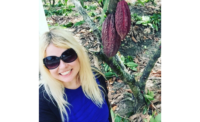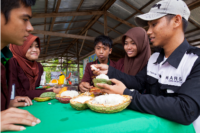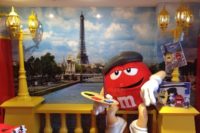It’s been about two years since Salpa’s President Jean-Paul Burrus bought a cocoa plantation in Ecuador. And about a year and a half since he bought a second one.
It hasn’t exactly been an easy road for the Swiss ceo though, who’s in his early 60’s and embarking on a new journey, with his company.
Aside from the South American country’s all-encompassing humidity, the seven-hour time difference and the language barriers, there’s also the fact that it takes at least three years for a cocoa tree to even produce usable pods.
And now, when Salpa needs chocolate, they have to do a lot more than call a supplier and request a shipment. When using supplies they grow themselves, they have to plan out at least three months in advance.
Of course, that doesn’t mean Burrus regrets his decision to invest in cocoa plantations for even a second. In fact, when asked if there was a moment he knew he made the right decision to purchase the fields, he says, 100 percent of every single day.
“I’m 62, and to have a new project like this, it’s very exciting,” he says.
Plus, he just wears hats in the fields to fight the sun, he sleeps well on planes so the jet lag doesn’t bother him, and his wife is fluent in Spanish. As for the cocoa, well he’s willing to wait three years for usable pods if it means he gets total control over the entire process.
“It’s very exciting because we control the quality of the bean,” Burrus says.

Turning beans into chocolates
It’s been an incredible two years for Burrus and The Salpa Group, which owns the French chocolate brand Yves Thuriès.
Salpa, which sells chocolate, coffee and tea under various brands, sells its chocolate under the Yves Thuriès brand in the United States, named after Yves Thuries, a well-known pastry chef who has twice been awarded “Best Craftman” in France.
All of the company’s chocolates are produced in France, and the brand’s signature is the macaron shape, which comes in flavors like crème brulee, key lime, tea matcha, peppermint. And of course, Yves Thuries creates new recipes every year taking into consideration the local tastes but with a French style and French production.
“We want to offer something unique to our consumers” says Charlotte Courcier, export general manager.

And now, just two years after buying the cocoa fields in Ecuador, nearly all the chocolate for Salpa’s confectionery brands like Yves Thuries (pictured) is being supplied with cocoa from the Ecuador plantations, named San Fernando One and San Fernando Two as a tribute to Fernand Burrus, Jean-Paul’s grandfather a chocolate industry pioneer in Eastern France.
In total, between the two farms, Salpa has 500 hectares of cocoa tree plantations, and supplies about 700 tons of raw cocoa to the flagship chocolate makers in the group, which is about 70 percent of all the cocoa mass they use. By next year, he hopes that’s at 100 percent.
Aside from the fact that it takes a long time to get usable pods from a cocoa tree, Burrus also didn’t want to switch over to his cocoa too fast, lest he risk changing the flavor profile too dramatically, too quickly.
And although he loves having control over the entire chocolate-making process — literally from bean to bar — he says it’s been even more important for the company to have an authentic story to tell.

Burrus and his wife Catherine regularly invite people down to see the fields themselves, giving them the chance to see where chocolate comes from first hand. For example, while the company was hosting Candy Industry Magazine, Burrus was also simultaneously hosting two Swiss chocolate makers, Nicolas Bihler and his father Jean-Willy, of Goldkenn Swiss Chocolate. The company uses chocolate from Salpa’s fields in Ecuador to make creations like The Goldkenn gold bullion bar.
And it’s impossible not to be in awe of the experience. Walking through the dirt paths in the cocoa fields and seeing the little pink flowers on the trees that blossom into tiny red cocoa pods that eventually grow big enough to harvest is breathtaking.
“We have increased our sales because we can communicate about our cocoa from Ecuador,” Burrus says. “It’s a big motivation for our customers.”

Salpa also has a banana plantation (pictured) on one of the farms, which were more of a happenstance than an outright decision. They were part of the farm that Burrus purchased, so he decided to get into the banana exporting business. And it has the added benefit of helping his cocoa fields, where banana trees can offer shade to young cocoa trees that only grow when they aren’t in direct sunlight.
Burrus chose South America over Africa — another part of the world where cocoa grows well, and which is a little closer to France — for a number of reasons. The most important of which is that you can’t hold a land title in Africa, but you can in South American countries.
As for why he specifically picked Ecuador, it was part fate and part good business sense.
Burrus knew someone in France who had a farm in Ecuador and he helped Burrus see that he could actually own a field a world away. Then he met an Ecuadorian diplomat to France, and after that went well, he knew exactly where he wanted to purchase his cocoa plantation.
Plus many of the regulatory laws are similar in Ecuador to those in Europe.
There’s also the fact that Ecuador seems to be the perfect environment for his favorite crop.
“The cocoa from Ecuador is one of the best in the world,” Burrus says.

Burrus and his wife love the country so much that they recently bought a hacienda in Guayaquil, Ecuador, which is in the southern part of the country, so that they can have a permanent place to stay when they are in the country. It’s about two hours from one of the plantations, near Naranjal, and about an hour and a half from the other near Milagro.
He spends about 60 days a year in Ecuador, not that he’s complaining. Burrus loves the tropical atmosphere, the fresh seafood, and the delicious fruit. And his Spanish gets better every day.
It’s been quite the journey though.
“In the beginning it was a lot of work,” Burrus says. “I knew about cocoa, but there’s a big difference between knowing and doing.”
The real heart of the Ecuadorian operations though is Neil Chiquet, a Frenchnative who is living in Guayaquil and running Salpa’s operations in the country.
He fluidly swaps between French, English and Spanish in his daily work, and will likely forget more about cocoa trees than most people will ever know.
Chiquet was already working for a French cocoa company in Ecuador when Burrus tapped him to run his plantations in the country.
Burrus says Chiquet is vital because he’s a French man running the operations, which helps Burrus run a plantation a half a world away with confidence.
“You need to have your own people,” he explains.
Chiquet says it’s been an incredible experience, being in charge of such an operation, especially with someone like Burrus, who is always propelling things forward.
“Mr. Burrus is very passionate,” Chiquet says. “It’s very interesting to work with someone like him. Mr. Burrus says, ‘It would be nice to have some fruit trees,’ and I say, ‘Ok!’ And Mr. Burrus says, ‘It would be nice to have some coffee trees,’ and I say, ‘Ok!’ And Mr. Burrus says, ‘It would be nice to have a second plantation,’ and I say, ‘Ok!’”
It’s an attitude that has propelled the company so far so fast in Ecuador, and will likely continue to move things forward in the coming years. Burrus says he thinks it will be another three to four years before he really feels settled in the fields.
During the past 24 months though, they have already cloned cocoa trees and planted them, installed new irrigations systems, built new offices and a cafeteria where they feed the workers at least one free meal a day.
They also have worked to get UTZ certified. The UTZ certification was as much for the customers as it was to give Salpa a guide as to how to run a sustainable and responsible cocoa farm.
One of the UTZ standards requires anyone applying pesticides to wear protective gear, something that takes a little convincing with the native cocoa farmers who aren’t use to such precautions. UTZ also prohibits child labor and requires that all the children whose parents work on the farm go to school. Salpa also has to notify everyone before they fumigate any of the fields.
It’s all stuff Salpa is happy to do.

From clone to crop
One of the biggest issues with cocoa trees is that it takes three to five years before they produce pods that can be turned into chocolate. That’s a long time to go without a crop.
The farms that Burrus bought did already have mature trees, but he’s also planting new ones, which means parts of the fields won’t have anything usable for years.
However, they want to make sure they are growing the exact cocoa they want. They have put a lot of thought and effort into deciding between Nacional, which produces green and yellow cocoa pods and another variety called N51, which produces red pods.
While the Nacional is known for its flavor, the company has found a more popular variety named ECUAWA with a higher production rate. Chiquet says they have worked hard to grow this ECUAWA variety that also meets their taste standards. Currently they are growing some of each in the fields.
And the plants are all clones so that they can make sure they are getting exactly the cocoa they want, especially since it takes so long to get usable pods. Planting seeds would be too risky, Chiquet explains.
One of the most important things Chiquet oversees is how they can continue to improve production with things like better pruning methods and fertilization, as well as going in and removing pods with things like witch’s broom. All that work means they only lose about 10 percent of the harvest to various issues, while a typical cocoa farm in Ecuador sustains losses affecting 50 percent of its crop.
Turning those pods into cocoa is the most important thing though.

While the farms are harvesting all year, the majority of the cocoa pods are harvested between November and December each year. Once the white gooey seeds are cut from the pods, they are sorted and then sent to the on-site processing center run in conjunction with Cecao, an affiliate of Cemoi, close to the second cocoa plantation near Milagro.
Salpa only started building the processing center in Sept. 2015, and it was finished mere months ago in February 2016. Before that they were renting space.
At the processing center the beans are dried and fermented, then bagged and shipped to France to process them into chocolate liquor. After that, Salpa takes over the process again, and turns them into chocolate, which is then used by the company’s confectionery brands.
“We began with zero, and in two year, we put all this in place," Chiquet says. “We create it, we export it, we process it and we send it to Europe.”

Salpa’s expansive reach
While Salpa has only been in Ecuador for two years, the company has much deeper roots than that. Burrus represents the third-generation working in the confectionery business.
Salpa is a holding company born from the 1997 merger of the Compagnie Française de Chocolaterie et de Confiserie (CFCC) and the C colat et Confiserie de Luxe L) , two companies initially finded by Paul Burrus, J n-Paul’s father.
The Burrus family has been working in the chocolate business since 1912, acquiring chocolate brands Yves Thuries, Schaal, Salavin, and Marquise de Sevigne. And Jean- Paul Burrus extended t e product range by i grating Coffea, which specializes in coffee, and Comptoir Français de Thé, which specializes in tea.
Burrus says he always knew he wanted to work in the family business, and he started with alpa in 1980 as a sales manager and worked his way up the ranks. By 1990 he was a general manager, and was named president of the newly formed Salpa Group in 1996
His family is part Swiss and part French, so good chocolate runs in his veins. And he’s not the type to settle.
For example, Burrus doesn’t just own cocoa fields. Salpa also owns a hazelnut farm in France, Pépinière des noisetiers de Guyenne, which happens to have a vineyard attached. As a result, he’s also in the wine business. Burrus purchased it in 2001, as one of the first steps to controlling more of confectionery-making business.
The hazelnut farm supplies almost all of Salpa’s needs, and there’s even a surplus left over to sell to other companies. In total, they grow 100 tons of hazelnuts a year. And by 2020 they want to be growing 600 tons a year.
Salpa also has two chocolate museums, including: Les Secrets du Chocolat and Musee les Arts du Sucre et du Chocolat in the South of France. Les Secrets du Chocolat invites chocolate enthusiasts to discover the fabulous story of cocoa while the Musee les Arts du Sucre et du Chocolat showcases Yves Thuries expertise as a grand chef through a collection of artworks created solely from sugar and chocolate.
Burrus is obviously passionate about helping Salpa evolve and grow in new ways, and with the Ecuadorian cocoa fields, he was found a way to reach back to chocolate’s roots and propel the company forward at the same time.
At-a-Glance: Salpa
Headquarters: Strasbourg, France
Sales: €66 Million
Number of Employees: 512
Brands and ventures : Yves Thuries, Schaal Chocolatier, Marquise de Sévigné, Côte de France, Musée du chocolat, Arts du sucre, Comptoir Français du Thé, Herbapac, Coffea, Belco, Pfister Chocolatier, Salpa Ecuador, Pépinière des noisetiers de Guyenne, and Les Secrets des Grands Express.
Cocoa Fields: San Fernando One near Naranjal, Ecuador and San Fernando Two near Milagro, Ecuador.
Management Group: Jean-Paul Burrus, president; François de Bretagne, managing director; Charlotte Courcier, export general manager
Website: salpa.fr / yvesthuries-export.com





